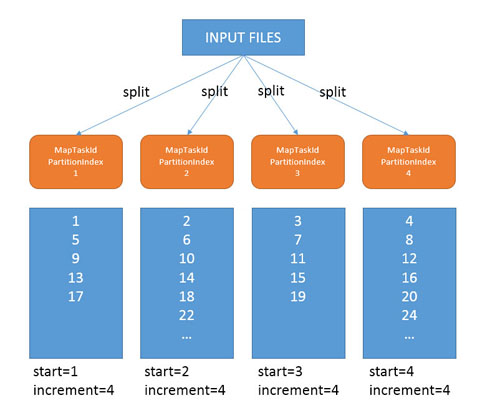在实际业务场景下,经常会遇到在Hive、MapReduce、Spark中需要生成唯一的数值型ID。
一般常用的做法有:
MapReduce中使用1个Reduce来生成;
Hive中使用row_number分析函数来生成,其实也是1个Reduce;
借助HBase或Redis或Zookeeper等其它框架的计数器来生成;
数据量不大的情况下,可以直接使用1和2方法来生成,但如果数据量巨大,1个Reduce处理起来就非常慢。
在数据量非常大的情况下,如果你仅仅需要唯一的数值型ID,注意:不是需要”连续的唯一的数值型ID”,那么可以考虑采用本文中介绍的方法,否则,请使用第3种方法来完成。
Spark中生成这样的非连续唯一数值型ID,非常简单,直接使用zipWithUniqueId()即可。
参考zipWithUniqueId()的方法,在MapReduce和Hive中,实现如下:
在Spark中,zipWithUniqueId是通过使用分区Index作为每个分区ID的开始值,在每个分区内,ID增长的步长为该RDD的分区数,那么在MapReduce和Hive中,也可以照此思路实现,Spark中的分区数,即为MapReduce中的Map数,Spark分区的Index,即为Map Task的ID。Map数,可以通过JobConf的getNumMapTasks(),而Map Task ID,可以通过参数mapred.task.id获取,格式如:attempt_1478926768563_0537_m_000004_0,截取m_000004_0中的4,再加1,作为该Map Task的ID起始值。注意:这两个只均需要在Job运行时才能获取。另外,从图中也可以看出,每个分区/Map Task中的数据量不是绝对一致的,因此,生成的ID不是连续的。
下面的UDF可以在Hive中直接使用:
- package com.lxw1234.hive.udf;
- import org.apache.hadoop.hive.ql.exec.MapredContext;
- import org.apache.hadoop.hive.ql.exec.UDFArgumentException;
- import org.apache.hadoop.hive.ql.metadata.HiveException;
- import org.apache.hadoop.hive.ql.udf.UDFType;
- import org.apache.hadoop.hive.ql.udf.generic.GenericUDF;
- import org.apache.hadoop.hive.serde2.objectinspector.ObjectInspector;
- import org.apache.hadoop.hive.serde2.objectinspector.primitive.PrimitiveObjectInspectorFactory;
- import org.apache.hadoop.io.LongWritable;
- @UDFType(deterministic = false, stateful = true)
- public class RowSeq2 extends GenericUDF {
- private static LongWritable result = new LongWritable();
- private static final char SEPARATOR = '_';
- private static final String ATTEMPT = "attempt";
- private long initID = 0l;
- private int increment = 0;
- @Override
- public void configure(MapredContext context) {
- increment = context.getJobConf().getNumMapTasks();
- if(increment == 0) {
- throw new IllegalArgumentException("mapred.map.tasks is zero");
- }
- initID = getInitId(context.getJobConf().get("mapred.task.id"),increment);
- if(initID == 0l) {
- throw new IllegalArgumentException("mapred.task.id");
- }
- System.out.println("initID : " + initID + " increment : " + increment);
- }
- @Override
- public ObjectInspector initialize(ObjectInspector[] arguments)
- throws UDFArgumentException {
- return PrimitiveObjectInspectorFactory.writableLongObjectInspector;
- }
- @Override
- public Object evaluate(DeferredObject[] arguments) throws HiveException {
- result.set(getValue());
- increment(increment);
- return result;
- }
- @Override
- public String getDisplayString(String[] children) {
- return "RowSeq-func()";
- }
- private synchronized void increment(int incr) {
- initID += incr;
- }
- private synchronized long getValue() {
- return initID;
- }
- //attempt_1478926768563_0537_m_000004_0 // return 0+1
- private long getInitId (String taskAttemptIDstr,int numTasks)
- throws IllegalArgumentException {
- try {
- String[] parts = taskAttemptIDstr.split(Character.toString(SEPARATOR));
- if(parts.length == 6) {
- if(parts[0].equals(ATTEMPT)) {
- if(!parts[3].equals("m") && !parts[3].equals("r")) {
- throw new Exception();
- }
- long result = Long.parseLong(parts[4]);
- if(result >= numTasks) { //if taskid >= numtasks
- throw new Exception("TaskAttemptId string : " + taskAttemptIDstr
- + " parse ID [" + result + "] >= numTasks[" + numTasks + "] ..");
- }
- return result + 1;
- }
- }
- } catch (Exception e) {}
- throw new IllegalArgumentException("TaskAttemptId string : " + taskAttemptIDstr
- + " is not properly formed");
- }
- }
有一张去重后的用户id(字符串类型)表,需要位每个用户id生成一个唯一的数值型seq:
- ADD jar file:///tmp/udf.jar;
- CREATE temporary function seq2 as 'com.lxw1234.hive.udf.RowSeq2';
- hive>> desc lxw_all_ids;
- OK
- id string
- Time taken: 0.074 seconds, Fetched: 1 row(s)
- hive> select * from lxw_all_ids limit 5;
- OK
- 01779E7A06ABF5565A4982_cookie
- 031E2D2408C29556420255_cookie
- 03371ADA0B6E405806FFCD_cookie
- 0517C4B701BC1256BFF6EC_cookie
- 05F12ADE0E880455931C1A_cookie
- Time taken: 0.215 seconds, Fetched: 5 row(s)
- hive> select count(1) from lxw_all_ids;
- 253402337
- hive> create table lxw_all_ids2 as select id,seq2() as seq from lxw_all_ids;
- …
- Hadoop job information for Stage-1: number of mappers: 27; number of reducers: 0
- …
该Job使用了27个Map Task,没有使用Reduce,那么将会产生27个结果文件。
再看结果表中的数据:
- hive> select * from lxw_all_ids2 limit 10;
- OK
- 766CA2770527B257D332AA_cookie 1
- 5A0492DB0000C557A81383_cookie 28
- 8C06A5770F176E58301EEF_cookie 55
- 6498F47B0BCAFE5842B83A_cookie 82
- 6DA33CB709A23758428A44_cookie 109
- B766347B0D27925842AC2D_cookie 136
- 5794357B050C99584251AC_cookie 163
- 81D67A7B011BEA5842776C_cookie 190
- 9D2F8EB40AEA525792347D_cookie 217
- BD21077B09F9E25844D2C1_cookie 244
- hive> select count(1),count(distinct seq) from lxw_all_ids2;
- 253402337 253402337
limit 10只从第一个结果文件,即MapTaskId为0的结果文件中拿了10条,这个Map中,start=1,increment=27,因此生成的ID如上所示。
count(1),count(distinct seq)的值相同,说明seq没有重复值,你可以试试max(seq),结果必然大于253402337,说明seq是”非连续唯一数值型ID“.





































